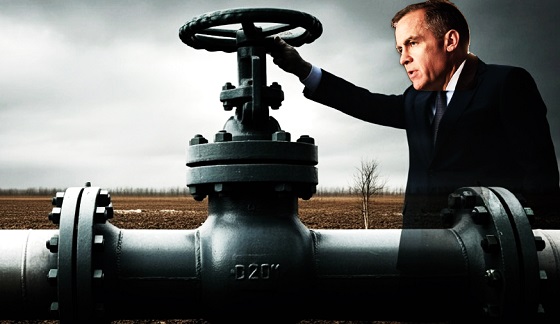Canadian Energy Centre
‘Big vulnerability’: How Ontario and Quebec became reliant on U.S. oil and gas

From the Canadian Energy Centre
ARC Energy Institute leaders highlight the need for a new approach in a new reality
Despite Canada’s status as one of the world’s largest oil and gas producers, more than half of the country’s own population does not have true energy security – uninterrupted, reliable access to the energy they need at an affordable price.
Even though Western Canada produces much of the oil consumed in Ontario and Quebec, in order to get there, it moves on pipelines that run through the United States.
“It’s only energy secure if the Americans are our partners and friends,” leading energy researcher Jackie Forrest said on a recent episode of the ARC Energy Ideas podcast.
Amid rising trade tensions with the United States, energy security is taking on greater importance. But Forrest said the issue is not well understood across Canada.
“The concern is that in the worst-case scenario where the Americans want to really hurt our country, they have the ability to stop all crude oil flows to Ontario,” she said.
That action would also cut off the majority of oil supply to Quebec.
The issue isn’t much better for natural gas, with about half of consumption in Ontario and Quebec supplied by producers in the U.S.
“Tariffs or no tariffs, there is a real vulnerability there,” said Forrest’s co-host Peter Tertzakian, founder of the ARC Energy Research Institute.
The issue won’t go away with increased use of new technology like electric cars, he said.
“This isn’t just about combustion in engines. It’s about securing a vital commodity that is an input into other parts of our manufacturing and sophisticated economy.”
Oil: The Enbridge Mainline
The Enbridge Mainline is the main path for oil from Western Canada to reach refineries in Ontario and Quebec, according to the Canadian Association of Petroleum Producers (CAPP).
 Originating in Edmonton, Alberta, the Enbridge Mainline moves crude oil, refined products, and natural gas liquids through a connected pipeline system. At Superior, Wisconsin, the system splits into Line 5, going north of Lake Michigan, and Lines 6, 14, and 61, going around the southern tip of the lake. The two routes then coalesce and terminate in Sarnia, Ontario, where it is interconnected with Line 9, which is terminated in Montreal, Quebec. Source: Canadian Association of Petroleum Producers
Originating in Edmonton, Alberta, the Enbridge Mainline moves crude oil, refined products, and natural gas liquids through a connected pipeline system. At Superior, Wisconsin, the system splits into Line 5, going north of Lake Michigan, and Lines 6, 14, and 61, going around the southern tip of the lake. The two routes then coalesce and terminate in Sarnia, Ontario, where it is interconnected with Line 9, which is terminated in Montreal, Quebec. Source: Canadian Association of Petroleum Producers
Originally built in 1950 from Edmonton to Superior, Wisconsin, in 1953, it was extended to Sarnia, Ontario through a segment known as Line 5.
CAPP said that at the time, politicians had pushed for an all-Canadian path north of the Great Lakes to increase energy security, but routes through the U.S. were chosen because of lower project costs and faster timelines.
In 1979, an extension of the pipeline called Line 9 opened, allowing oil to flow east from Sarnia to Montreal.
“Line 9 was built after the oil crisis and the OPEC embargo as a way to bring western Canadian crude oil into Quebec,” Forrest said.
But by the 1990s – before the massive growth in Alberta’s oil sands – there was a lack of crude coming from Western Canada. It became more economically attractive for refineries in Quebec and Ontario to import oil from overseas via the St. Lawrence River, CAPP said.
A reversal in 1999 allowed crude in Line 9 to flow west from Montreal to Sarnia.
By the 2010s, the situation had changed again, with production from the Alberta oil sands and U.S. shale plays surging. With more of that oil available, the offshore crude was deemed to be more expensive, Forrest said.
In 2015, Line 9 was reversed to send oil east again from Sarnia to Montreal, displacing oil from overseas but not resolving the energy security risk of Canadian pipelines running through the U.S.
CAPP said the case of Line 5 illustrates this risk. In 2020, the Governor of Michigan attempted to shut down the pipeline over concerns about pipeline leak or potential oil spill in a seven-kilometre stretch under the Straits of Mackinac.
Line 5 has been operating in the Straits for 72 years without a single release.
Enbridge is advancing a project to encase the pipeline in a protective tunnel in the rock beneath the lakebed, but the legal battle with the State of Michigan remains ongoing.
Natural gas: The TC Canadian Mainline
The natural gas pipeline now known as TC Energy’s Canadian Mainline from Alberta was first built in 1958.
 The TC Canadian Mainline (red dashed line) transports natural gas produced in Western Canada to markets in Eastern Canada. Red lines show pipelines regulated by the Canada Energy Regulator, while black lines show pipelines regulated by the United States. Source: Canadian Association of Petroleum Producers
The TC Canadian Mainline (red dashed line) transports natural gas produced in Western Canada to markets in Eastern Canada. Red lines show pipelines regulated by the Canada Energy Regulator, while black lines show pipelines regulated by the United States. Source: Canadian Association of Petroleum Producers
“This pipeline brought gas into Ontario, and then it was extended to go into Quebec, and that was good for a long time,” Forrest said.
“But over time we built more pipelines into the United States, and it was a better economic path to go through the United States.”
The Mainline started running not at its full capacity, which caused tolls to go up and made it less and less attractive compared to U.S. options.
According to CAPP, between 2006 and 2023 the Mainline’s deliveries of gas from Western Canada to Ontario and Quebec were slashed in half.
“We should have said, ‘We need to find a way for this pipeline, over our own soil, to be competitive with the alternative’. But we didn’t,” Forrest said.
“Instead, we lost market share in Eastern Canada. And today we’re in a big bind, because if the Americans were to cut off our natural gas, we wouldn’t have enough natural gas into Quebec and Ontario.”
A different approach for a new reality
Forrest said the TC Mainline, which continues to operate at about half of its capacity, presents an opportunity to reduce Canada’s reliance on U.S. natural gas while at the same time building energy security for oil.
“Those are the same pipes that were going to be repurposed for oil, for Energy East,” Tertzakian said.
“The beauty of the thing is that actually, I don’t think it would take that long if we had the will… It’s doable that we can be energy secure.”
This could come at a higher cost but provide greater value over the long term.
“That’s always been the issue in Canada, when it comes to energy, we always go with the cheapest option and not the most energy secure,” Forrest said.
“And why? Because we always trusted our American neighbor to never do anything that will impact the flow of that energy. And I think we’re waking up to a new reality.”
Canadian Energy Centre
RBC says Canada’s Indigenous owned energy projects are ‘economic reconciliation in action’
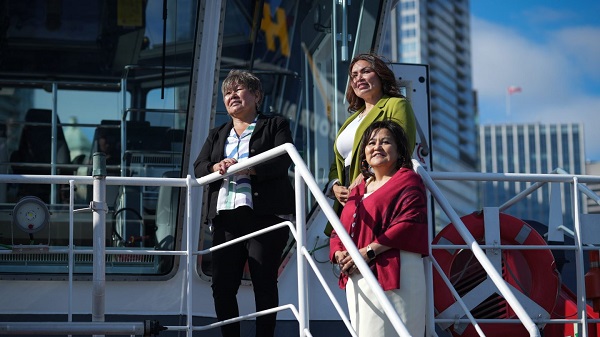
Eva Clayton, back left, President of the Nisga’a Lisims Government (joint venture owner of the proposed Ksi Lisims LNG project), Crystal Smith, back right, Haisla Nation Chief Councillor (joint venture owner of the Cedar LNG project, now under construction), and Karen Ogen, front right, CEO of the First Nations Natural Gas Alliance pose for a photograph on the HaiSea Wamis zero-emission tugboat outside the LNG2023 conference, in Vancouver, B.C., Monday, July 10, 2023. CP Images photo
From the Canadian Energy Centre
As construction gets underway on Cedar LNG, the world’s first Indigenous majority-owned LNG export terminal, a report from RBC highlights the project as a model of successful energy development in Canada.
“We broke a pattern that had existed for over a century,” said Karen Ogen, CEO of the First Nations Natural Gas Alliance.
“First Nations have been at the heart of the LNG opportunity, not on the sidelines or just on the job sites but in the boardrooms helping to make it happen.”
RBC said the Cedar LNG project in Kitimat, B.C. – a partnership between the Haisla Nation (50.1 per cent) and Pembina Pipeline Corporation (49.9 per cent) – is a model for Indigenous economic reconciliation in action.
“Canada’s future growth and prosperity depends heavily on getting Indigenous economic reconciliation right,” said report co-author Varun Srivatsan, RBC’s director of policy and strategic engagement.
“If not, the country’s ability to diversify our resource exports, enjoy independence and resiliency in strategic sectors, and improve productivity, which has lagged that of other countries for years, are all at risk.”
RBC outlined the enormous potential of Indigenous-led energy projects to drive economic growth.

Almost three-quarters of the 504 major resource and energy projects planned or underway in Canada run through or are within 20 kilometres of Indigenous territories.
The value of Indigenous equity opportunity from these projects is estimated at $98 billion over the next 10 years, with oil and gas projects dominating the list at $57.6 billion.
“It’s clear that First Nations are critical to LNG in Canada. It’s First Nations territory from where the gas is extracted in Treaty 8 territory, it’s First Nations territory across which gas is transported via pipeline, it’s First Nations territory where LNG terminals are located, and it’s First Nations waters through which carriers take LNG to market. This is why we say Canadian LNG is Indigenous LNG. And we are going to make history,” Ogen said.
Cedar LNG reached a final investment decision last June, following a permitting process that saw the Haisla Nation directly involved in planning the facilities and operations.
This includes a floating LNG terminal with emissions among the world’s lowest, at 0.08 per cent CO2 equivalent per tonne of LNG compared to the global average of 0.35 per cent. Operations are slated to start in late 2028.
“Our community felt it was important that our values of being Haisla, being Indigenous, were felt through every decision that was being made. That is what makes this project unique,” said Crystal Smith, the Haisla Nation’s elected chief councillor.
Central to the Haisla’s involvement in Cedar LNG are the jobs and ongoing revenues that benefit the nation and neighbouring communities.
This has included support for education and cultural programs and building a state-of-the-art health facility and a new housing development.
“Cedar LNG shows what is achievable when you have a shared vision,” Smith said.
“It is going to mean that my kids and grandkids have a different future from what I or anybody in my generation have experienced in our community. It is going to revive our culture, revive our language, and make us stronger going forward.”
Alberta
As LNG opens new markets for Canadian natural gas, reliance on U.S. to decline: analyst
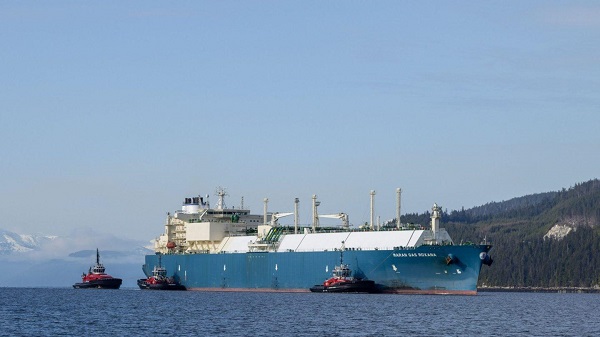
From The Canadian Energy Centre
By Cody Ciona
Starting with LNG Canada, producers will finally have access to new customers overseas
Canada’s natural gas production and exports are primed for growth as LNG projects come online, according to Houston, Texas-based consultancy RBN Energy.
Long-awaited LNG export terminals will open the door to Asian markets and break the decades-long grip of the United States as the sole customer for Canada’s natural gas.
RBN projects that Canada’s natural gas exports will rise to 12 billion cubic feet per day (bcf/d) by 2034, up from about 8 bcf/d today. But as more LNG terminals come online, less of that natural gas will head south.
“We think the real possibility exists that the amount of natural gas being exported to the United States by pipeline will actually decline,” said Martin King, RBN’s managing director of North America energy market analysis, on a recent webinar.
RBN’s analysis suggests that Canada’s natural gas exports to the United States could drop to 6 bcf/d by the early 2030s compared to around 8 bcf/d today.
With the first cargo from the LNG Canada terminal at Kitimat, B.C. expected to ship in late June, Canada will finally have access to new markets for natural gas. The first phase of the project will have capacity to ship about 1.8 bcf/d.
And more projects are on the way.
LNG Canada’s joint venture partners are considering a second phase that would double export capacity.
Also at Kitimat, the Cedar LNG project is under construction and is expected to be completed in 2028. The floating terminal led by the Haisla Nation will have capacity to export 0.4 bcf/d.
Woodfibre LNG, located near Squamish, B.C. began construction in late 2023 and is expected to be substantially completed by 2027, with export capacity of about 0.3 bcf/d.
Expansions of LNG Canada and Cedar LNG could put LNG exports into the range of 5 bcf/d in the early 2030s, King said.
-
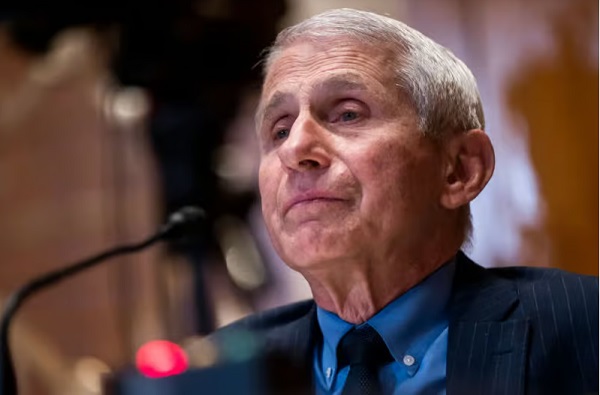
 Brownstone Institute4 hours ago
Brownstone Institute4 hours agoAnthony Fauci Gets Demolished by White House in New Covid Update
-
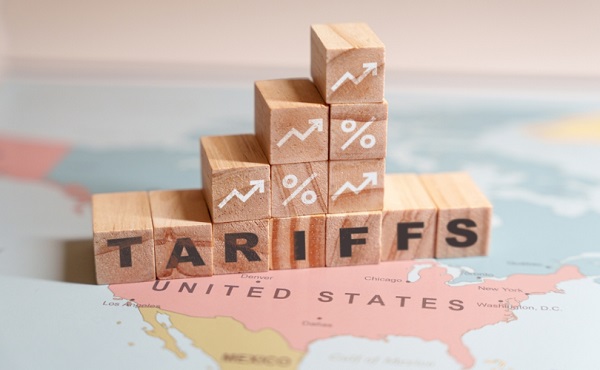
 Business5 hours ago
Business5 hours agoSobering reality check – Trump is right: Canada’s economy can’t survive a fair trade agreement with the US
-

 Crime3 hours ago
Crime3 hours agoMexican Cartels Expanding Operations in Canada, Using Indigenous Reserves as Factory Hubs
-

 Fraser Institute7 hours ago
Fraser Institute7 hours agoDeclining stature of foreign affairs minister underscores Canada’s waning influence on world stage
-

 Business6 hours ago
Business6 hours agoOttawa must listen to the West
-

 Alberta1 day ago
Alberta1 day agoAlberta’s Environmental Changemakers Shine at the 2025 Emerald Awards
-

 Banks1 day ago
Banks1 day agoLiberal border bill could usher in cashless economy by outlawing cash payments
-

 Business1 day ago
Business1 day agoBeef is becoming a luxury item in Canada


